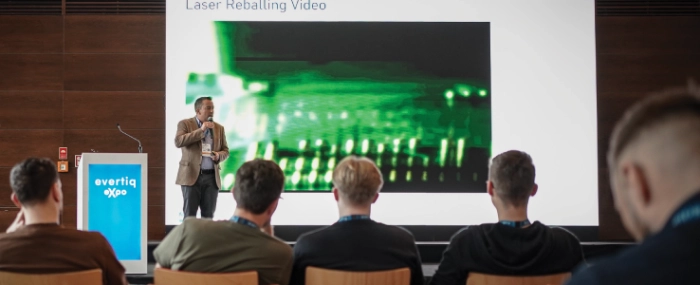
The European duo driving a greener electronics industry
Stephan Theil, CEO of the German company Factronix, presented technologies and processes at Evertiq Expo Warsaw 2025 that can drastically reduce electronics manufacturing costs, carbon footprint and dependence on unstable supply chains.
“Wherever electronics are part of the game, we are part of the game,” Theil began.
He then explained in detail how component recovery can become a pillar of responsible and cost-effective production.
Global structure, local solutions
Factronix was founded in 2007 in Germany and has focused from the very beginning on quality, repeatability and compliance with the stringent standards used in sectors such as automotive and defence. The company’s headquarters are located in Wörthsee, Bavaria, just outside Munich — one of Europe’s key technology hubs. This is where the central testing laboratories and engineering teams are located, responsible for developing new methods of component recovery and refurbishment.
Factronix also operates a small facility in the Czech Republic near the German border, serving as an operational and logistics centre. This site handles smaller-scale projects, short production runs and the first stages of component qualification. Thanks to its location, the company can serve customers in Poland, Slovakia and Austria much faster, significantly reducing transport time for boards and components destined for recovery.
However, the largest and most crucial part of the entire structure is Retronix — a long-term partner located in Coatbridge, near Glasgow, Scotland. Retronix has operated since the 1990s and specialises in precision SMD rework, reballing and automated retinning. Theil calls the Scottish facility “the heart of the operation”: it is equipped with advanced laser lines, robotic tinning and lead regeneration workstations, as well as comprehensive optical and X-ray inspection systems. This is where the most demanding work is carried out, supporting sectors such as aerospace and defence, automotive, energy, IT, data centres and electronic device manufacturing of all kinds.
The long-standing Factronix–Retronix cooperation is built on a division of competencies:
- the Bavarian site functions as the technical and customer interface for continental Europe,
- the Czech facility handles rapid deployments and smaller processes,
- while the Scottish factory operates as a high-volume production base capable of processing hundreds of thousands of components.
Together, they form a complete service ecosystem that combines expertise, experience and highly specialised technology — from laser BGA reballing to the refurbishment of microscopic 0402 components used in space missions.
“No matter if it’s defence, automotive or telecommunications — if a component has value and can be recovered, we can do it,” Theil emphasised.
Why Component Recovery Is Becoming a Strategic Necessity
The carbon footprint of electronics manufacturing
As Theil explained to attendees at Evertiq Expo Warsaw 2025, EU governments are pushing for greater transparency and CO₂ reduction. This also applies to electronics, where — as he stressed — one specific stage of PCB manufacturing dominates environmental impact.
“Do you know which PCB manufacturing process generates the highest CO₂ cost? Soldering. Around 70% of the total carbon footprint of a printed circuit board is created there.”
If producing new components carries such a substantial climate burden, recovery becomes not only sensible but necessary.
Rising costs and economic pressure
Companies are increasingly examining their production waste. Theil noted that typical losses amount to 3–5% of all components.
“Before you throw anything away, think. Many parts can be recovered, refreshed and restored to full functionality — at a lower cost than buying new ones,” the Factronix CEO said.
Supply chain crises
Component shortages continue to affect production. Theil referenced a well-known case from Germany:
“Volkswagen stopped production. Why? Because they didn’t get chips from China! We are returning to familiar problems — blockages in the supply chain.”
Such events are often the trigger for dismantling inventory and recovering components.
Managing discontinued parts
Theil explained that industries such as rail, automation, defence and energy often operate under 10- or even 20-year parts availability requirements.
“Very often, we take old PCBs and recover valuable components from them. Thanks to this, customers can keep their systems running for many years.”
Circular economy in practice: What the recovery process looks like
Visitors at Evertiq Expo Warsaw 2025 were introduced to the four-step recovery model used by the Factronix–Retronix partnership:
- Component removal
Using infrared heating that minimises thermal stress.
“We try to avoid high temperatures whenever possible,” Theil remarked. - Cleaning and inspection
Automated optical systems verify the quality of each component before further processing. - Reballing or retinning
Including various lead preparation methods such as laser BGA reballing (a unique, zero-thermal-stress process) and full reflow reballing. - Testing and packaging
Performed to AS6081 standards, with optional solderability testing.
Laser reballing: A technology no one else has
Theil dedicated a large part of his presentation to laser BGA reballing — a solution that sidesteps one of the biggest limitations of IC reuse: the limited number of allowed reflow cycles.
He explained that traditionally, each BGA component has three available reflow cycles:
• one during original PCB assembly,
• one during component removal,
• and one during classic reballing in a reflow oven.
After that, manufacturers no longer guarantee reliability.
“Laser reballing does not consume a single cycle. It is the only method where we introduce no thermal stress at all,” Theil said.
Instead of heating the entire device, the system places individual solder balls — one per second — in a controlled CO₂ environment without using flux. As a result, the IC remains fully compliant with factory specifications and avoids damage typical of traditional reballing.
This precision is crucial in sectors where component lifetimes are long, and their value far exceeds the cost of reballing.
How big can the savings be?
At Evertiq Expo Warsaw 2025, Theil shared examples of projects where the Factronix–Retronix model proved exceptionally effective.
One case involved a telecom client holding large inventories of discontinued telephone cards containing expensive, rare and no-longer-produced ICs.
The client asked if these chips could be recovered and restored. What began as a months-long project turned into a multi-year operation: over three years, the team recovered top-tier components, removed oxidation, performed laser BGA reballing and ran full functional testing.
In total, over half a million ICs were returned to usable condition, saving the client approximately USD 10 million.
“Instead of scrapping a massive batch of hardware, they put it back into circulation — fully functional and fully compliant. When you look at the numbers, it’s hard to believe these parts were meant to be thrown away,” Theil commented.
Throughout his talk, Theil repeated the same message: economics and ecology must go hand in hand.
“Recycling has to be cheaper than buying a new part. Otherwise, it makes no sense.”
“Our vision of circular economy is not a marketing slogan. It’s real money, real savings and real CO₂ reduction.”
At a time of global shortages, rising production costs and increasingly strict environmental regulations, the Factronix–Retronix approach is emerging as one of the most forward-looking directions in the electronics industry.
The next Evertiq Expo Warsaw will take place on 22 October 2026. Join the community of specialists who — just like the Factronix–Retronix duo — are shaping the future of electronics responsibly.

